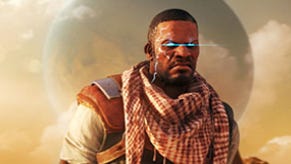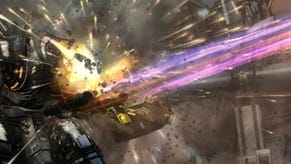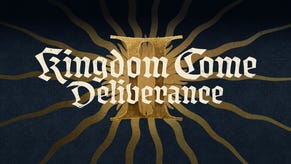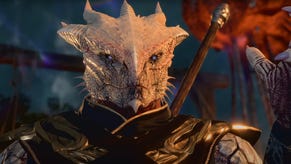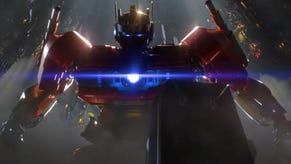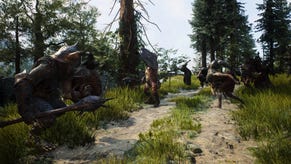Sony's final frontier: Starhawk unveiled in London
Sony has finally unveiled Warhawk sequel Starhawk, showing the game to press in London this week. Quotes, impressions, shots, trailer, dev diary inside.
The games industry has gone multiplayer mad in recent years, as developers and publishers try to shoehorn online modes into games that would largely be better defined as tightly-focused single-player-only experiences. For every game in which the multiplayer gamble pays off, there’s another in which its inclusion feels tacked-on, serving only to tick a box on a design-by-committee ‘how to build a blockbuster’ feature sheet.
Starhawk is an oddity in this respect - it’s moving in the opposite direction. The follow-up to 2007’s PS3-exclusive, multiplayer-only title Warhawk, is adding a single-player mode where previously there was none.
Starhawk is the first full release from LightBox Interactive, a studio based in Austin, Texas, and born out of collaboration between Sony’s Santa Monica Studio and the developer of the original Warhawk title, the now disbanded Incognito Entertainment. We went along for the game’s unveiling this week to spend some hands-on time with the single and multiplayer builds, and to hear what two of the game’s senior staff had to say about their efforts to improve on a solid multiplayer experience whilst introducing a single-player campaign they hope will disrupt the linear nature of many a shooter.
Fly me to the moon
Starhawk takes place on the Frontier, a number of loosely connected human colonies in the outer reaches of space. The colonies are built around valuable Rift plains that are mined to provide power for the colonies, but the mining comes at a cost.
“Exposure to Rift energy is irrevocably dangerous,” explains LightBox Interactive’s president, Dylan Jobe. “It can cause your flesh to drip from your bones, your skeleton to push out through your skin and ultimately it drives you mad.”
Apparent carelessness during the mining of this volatile energy source has led to the formation of two factions: the human miners or ‘Rifters’ who mine Rift energy safely and responsibly, and the Outcasts; a group that look to have skipped the health and safety part of their employment briefing and are now paying for it with the melting flesh, jutting bones and slight case of the crazies that Jobe warns of.
The hero of this cautionary tale is one Emmett Graves. Graves has been exposed to just a smidgen of Rift energy that has caused a partial mutation of one side of his body, fortunately the infection is being kept in check by a Rift regulator fitted to Graves’ back by his technically-gifted Rifter partner, Cutter - who is currently sporting what sounds like a mangled South African accent.
“Graves is really like a ticking time-bomb at this point” explains Jobe. “He knows he may succumb to the infection at any point, and that it will likely kill him.”
Together, Graves and Cutter make their living as Rift salvagers, travelling from moon to moon attempting to protect the Rift plains and geysers that the Outcasts worship and wish to claim for themselves. And where salvager and the once company-loyal Outcasts meet, nary an employment tribunal will suffice to keep the peace.
Build me up, Buttercup
“Most shooters provide a linear point-to-point path with the same enemy placement every time so that you could play the same mission ten times and it will play out almost the same way every time. We wanted to get rid of that,” explains Jobe. “The single-player mode in Starhawk should not be considered as a pathway from A to B with a rigid layout, but rather an arena - a region of gameplay. Instead of specific enemy placement we’ve got spawn regions, with the enemy types and tempo at which they spawn controlled by the game system. Furthermore, in direct response to the static layout found in so many shooters, we’re empowering players to place their own structures, creating dynamic levels. Placing walls and bunkers, building launch pads that give access to vehicles, creating towers that provide weapons and gift elevated positions from which to gain advantage. We call this system Build and Battle.”
Build and Battle is what LightBox hopes will provide Starhawk’s unique edge and is a system that effectively adds elements of RTS to this third person shooter. It doesn’t take long to understand how it works. Having cleared an area of Outcasts and reclaimed a Rift geyser at the start of our single-player hands-on we’re informed by Cutter that Outcast reinforcements are on their way, triggering a countdown to the impending wave of enemies.
Calling up a radial menu presents a number of build options - which we’re told are context sensitive depending on the mission type you are undergoing – with each build item costing a certain amount of Rift energy that is dropped by the dispatched Outcasts. What follows is the preparation of a battleground for the coming onslaught. Passive, defensive wall structures are strategically placed to provide cover for the more aggressive build types, such as sentry guns, anti-air pods and sniper towers. The three most expensive build types available in this hands-on are the comms tower: that producers a number of AI bots that will fight alongside you - a garage: which spawns a Warthog-style buggy armed with a mannable machine gun - and the launch pad: from which the titular mech-like Hawks can be launched, providing a powerful aerial combat option for you or the friendly bots spawned from the comms tower. As finite Rift energy is spent to place towers and create choke points it prompts memories of DS game Lock’s Quest, only in 3D and with a lot more grunt.
“We’re a third-person shooter first and foremost and we’ve integrated Build and Battle to add depth but also to provide very specific and fast gratification,” explains Sony Santa Monica Studios senior producer, Harvard Bonin. “We played around with build-times and the like but we found it was just getting in the way, so we decided to have the build options as this instant, on-the-fly process.”
Bonin isn’t exaggerating when he talks about the build options providing fast gratification. After selecting your build type you’re presented with a wireframe model of the structure that represents its size and shape in the gameworld, confirming placement of this model by pressing X sends an instruction to Cutter, who is orbiting high above, to hurl the build kit down from his ship which promptly self-assembles, Transformer-like, in a matter of seconds in front of your eyes. One day, this is how flat-pack furniture will be delivered in real life. It’s a smart-looking effect that has the added bonus in both single and multi-player games of acting as a huge crushing weight that you can drop atop your enemy – and allies unfortunate enough to get caught out by the express delivery of several tonnes of metal.
All for one and one for all
The single-player hands-on ends with us jumping atop a Hawk and taking to the skies to dispatch a number of enemy Hawks that are bombarding the ground-troops. Controls are responsive, the Hawks agile and a few aerial dogfights and slow motion explosions later we’re looking at the debriefing screen on which our performance is ranked and experience points doled out for build-types used, gun and melee kills accrued and vehicular destruction achieved. In the full game, this XP will translate into upgrade options for both Graves’ Rift-mutation powers and gun upgrades, which will be persistent across the single and multi-player modes.
"Happily we were able to really leverage the experience of the Santa Monica Studios’ God of War team for some of the single-player aspects."
With just a brief, single-player level on show it was hard to gauge the finer details of narrative and combat-balance but Bonin insists that, far from being a tacked-on experience, the single-player will deliver a worthwhile experience alongside the potentially show-stealing multi-player.
“It was critical for us to include single-player this time around,” insists Bonin. “Going from single to multi-player and vice versa are both tough things to do. Happily we were able to really leverage the experience of the Santa Monica Studios’ God of War team for some of the single-player aspects. Of course, Starhawk is a completely different experience to God of War but some of the rules for a single-player experience remain the same, such as clarity for the player, game pacing, and how you frame dramatic moments. It’s funny actually, so much of what makes a great single-player experience for the gamer can come down to just knowing what are you actually supposed to be doing next!”
As for the multi-player, with many of the build and battle structures being both upgradable and destructible it looks set to have the potential for all important ebb and flow. During the hands-on our team was able to establish a forward position with the creation of strategically placed armoury posts and sniper towers before being pushed back when these buildings were eventually destroyed by the opposing team and replaced with structures of their own.
It is intended that multi-player will take the form of a maximum 16v16 player battles and a likely minimum of 8v8. The final number of multiplayer modes is yet to be decided upon, with Bonin insistent that they want to get the balance right between giving everyone enough to do without risking fracturing the community.
Other features that are mentioned in passing but not discussed in detail at this unveiling are a co-op mode for up to four players, an Android app to keep players in-touch with the community, automated tournaments, an in-game calendar and cross-server voice chat.
Our primary concern for the game at this point is that the generic look of both the character models and environs does little to help establish any sort of distinctive visual identity. Both the single-player level at the Echo Postal Relay and the multi-player arena, Acid Sea, appear broadly the same at this stage, with the large open spaces necessary to accommodate the build and battle gameplay also looking a little like sparse grey-brown dustbowls. The Outcasts look to be a vanilla ghoul-type model, whilst the Rifter’s are garden variety space marines. Even Graves fails to cut a distinctive figure, with partial mutation hardly anything new and the Rift regulator grafted to his back reminiscent of Isaac Clarke’s health indicator in Dead Space.
However, visuals aside what we saw was an accomplished single and multi-player build. With Starhawk not launching until ‘some point’ in 2012, there’s plenty of time for the art team to ensure that the game’s appearance matches the potential shown by the mix of third-person shooter and RTS gameplay.
Starhawk is due for release on PS3 in 2012.










